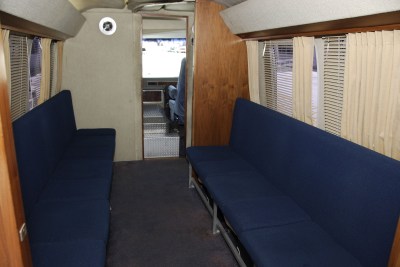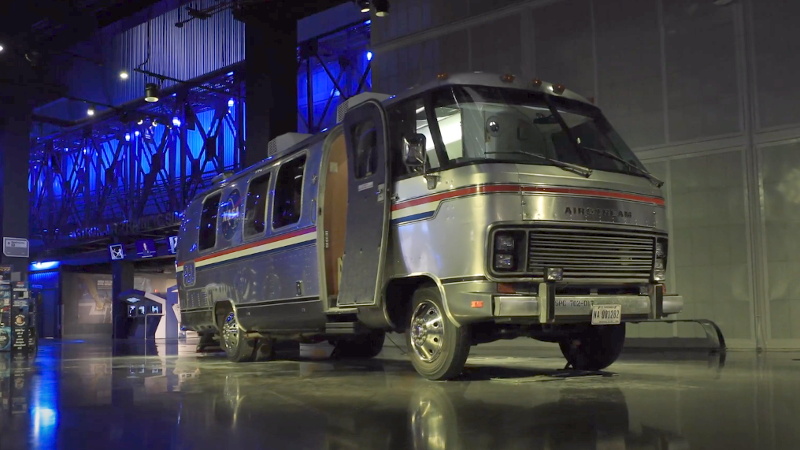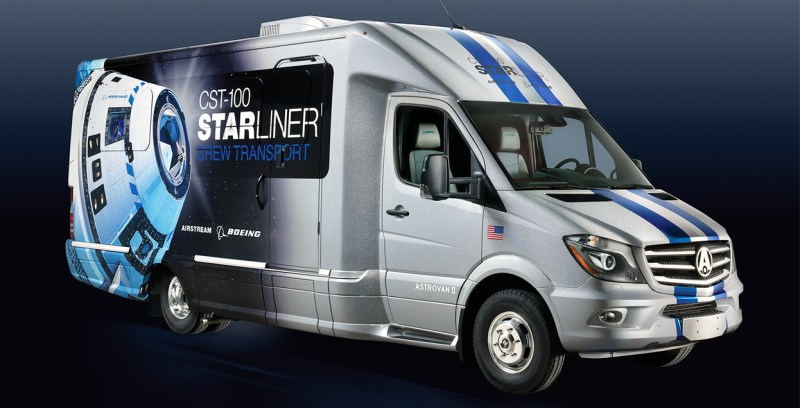Since the Apollo program, astronauts making the nine mile trip from the Operations and Checkout Building to the launch pad have rode in a specialized van that’s become lovingly referred to as the Astrovan. The original van, technically a modified motorhome, was used from 1967 all the way to the first Shuttle missions in 1983. From then on, a silver Airstream Excella emblazoned with the NASA “meatball” carried crews up until the final Shuttle rolled to a stop in 2011.
With crewed flights for the Artemis lunar program on the horizon, NASA has put out a call to companies that want to build a new Crew Transportation Vehicle (CTV). As you might expect from rocket scientists, the space agency has provided an exacting list of specifications for the new CTV, down to the dimensions of the doors and how many amps each of its 12 VDC power jacks must be able to handle. Perhaps most notably, NASA requires that the new 8-seat Astrovan be a zero-emission vehicle; which given the relatively short distance it has to drive, shouldn’t actually be too difficult.

In the document, NASA explains that the new CTV could either be a completely new one-of-a-kind vehicle, or a commercially available vehicle that has been suitably modified, as was the case with the previous vans. But interestingly, it also says they’re open to proposals for refurbishing the Shuttle-era 1983 Airstream and putting it back into service.
This is particularly surprising, as the vehicle is currently part of the Atlantis exhibit at the Kennedy Space Center. Presumably the space agency thinks there would be some bankable nostalgia should Artemis crews ride to the pad in the same van that once carried the Shuttle astronauts, but given the vehicle’s history and the fact that it’s literally a museum piece, it seems somewhat inappropriate. This is after all the very same van that once carried the Challenger and Columbia crews to their ill-fated spacecraft. Luckily, the chances of anyone willing to turn a 1983 Airstream into a zero-emission vehicle seem pretty slim.
If you’re wondering, SpaceX carries astronauts to the pad in specially modified Tesla Model X luxury SUVs, and Boeing has already partnered with Airstream to build their own Astrovan II. There’s still no date on when Boeing might actually get their CST-100 Starliner up to the International Space Station, but at least the van is ready to go.
















Ginger Billy is the guy NASA needs to see:
https://www.youtube.com/watch?v=7vxukz1x_eU
+1
“NASA requires that the new 8-seat Astrovan be a zero-emission vehicle”.
I look forward to their launch rockets being zero-emission too, otherwise it’s all rather hypocritical. I get rather fed up of being told to cut down on motoring, reduce my heating thermostat etc etc when there are aeroplanes buzzing around in the sky just for an individual’s fun, racing cars driving round and round in circles for hours, and yes, jollies into space.
Nasa generally isn’t involved in joyrides in space, but serious science, and its really not hypocritical to improve your footprint as technology allows. If you could make a magic no impact space launch system that is at all practical it would be done, maybe not really fast – it could be too costly to wholesale change the method used, but it would be done…
But as about the only 100% green way to get to space is not to its not going to happen – sure something like a massive solar/wind etc fed railgun launch system could be considered green, but not only would it cost a fortune to build but the launch vehicles would need massive amounts of heatshielding, going so fast at such low altitude, also ends up being nearly impossible to build one big enough to launch people, you have to get fast enough to escape but people can only pull a handful of G sustained, then you have to realise all that electricity could have been used for essential daily lives/industry type stuff – so it probably actually ends up with a worse environmental footprint!
I’d also personally not complain too much racecars, sure some of their use is purely frivolous and that is wasteful, but at the same time racing is a environmentally pretty cheap form of broadcast entertainment (probably greener than having all the audience play the F1 videogame for instance), inspires folks to become engineer/science types, creates improvements in the technologies that trickle down to normal vehicles in the end.
Aircraft are the same, plenty of wasteful use but also very useful – airfreight for instance allows more productive areas of perishable crops to get to food to places that need it (though there is of course argument on if such things help encourage poor faming practices/slash and burn of jungle etc).
In the end the only true ‘green’ thing a person can do is die out in the wilds somewhere, becoming food for the wildlife – living has a continued impact on the surroundings and the goal has to be keeping that impact controlled and not excessively destructive, while having a quality of life you find acceptable.
The core of the SLS uses hydrolox, so its emissions are just water.
(yes, the lateral boosters are a different thing…)
no, it’s not just water – the surrounding air is still here, so the hot exhaust from the engines actually has NOx emissions as well…
Uh, I guess you’re also fed up with knowing what “hypocritical” means.
It’s a specification for a vehicle that they are commissioning the construction of. Not a rule they’re imposing on someone else while not following it themselves. It’s not hypocritical to take steps towards polluting less than the maximum possible amount.
As for the “jollies into space” you must be thinking of SpaceX and Blue Origin sending bored billionaires to the edge of the atmosphere, because this vehicle would be transporting astronauts for missions of scientific significance.
SX’s only jolly ride was a multiday orbital one with its orbit higher than a Hubble ST. And SX is a transportation company not a turistic one flying international payloads every month. + On that one jolly ride at least they were doing some miniexperiments that wouldn’t be done at all or would take a time from precious schedule of NASA/ESA/whatever-goverment-agency employees on ISS.
BO is a touristic and a lawyer company. Their New Sheppard phalic rocket would need to have an order of a magnitude more energy to put *anything* into an orbit and there are gazillion other engineering chalanges going to orbit. Sorry but 100km height with zero vertical speed is a hobby & university realm.
Please do not compare any orbital transportation company or project, not just SX, to a joke called BO. You are belitteling hundreds of engineers.
+1
Don’t forget all the fossil fuels expended to get fans to sporting events, concerts, movies, museums, restaurants…
I mean, you just as well make all forms of entertainment illegal, right?
Before this happens, we should declare climate paranoia as a psychiatric disease which needs to be treated appropriately.
Thanks!
Out of curiosity at what point does understandable and well justified concern over how badly we are buggering up the planet become ‘climate paranoia’.
Its not that I think you are wrong as such, but there is and should be an expected degree of concern, and awareness of the impact you are having…
I am concerned about the possibility of AGW, and in my life I am doing some things to lessen my contribution to atmospheric carbon/methane. Personally, I feel that many of the “solutions” proposed by the UN and other organizations are more about increasing their political power than decreasing global contributions.
Basically, why am I asked to make hard “choices” when the 2 largest countries (population wise) are exempt from the CO2 emission accords?
I agree. I do believe ‘natural climate change and how to prevent it’ is becoming a disease/obsession to a segment of our population.
NASA right now is really beating the climate change manta due to current administration fixation.
It’s only natural if you consider humanity polluting to be natural.
So you are a climate science denier, eh?
Hydrogen + oxygen = water.
They’re already zero emission.
So the actual linked posting is pretty short, and makes it clear that the zero emissions thing is a requirement across the us federal government (executive order for improving competitiveness in EVs which makes sense: if any government agency is going to pay for development work on a custom or semi custom vehicle, it seems like sound policy to require that money also improve the national experience with EVs.)
I know even I comment before reading the linked thing, and sometimes folks just have things on their chest they gotta say, but that was actually a pretty easy one to dig into.
Pff. remote-emission would be a better naming. sure, you can claim that your energy comes from renewable sources, but unless you charge that van from a onsite solar array and build it by hand from locally sourced wood, there are emissions involved.
but besides that, why not power it from the same rocket fuel used in the craft they ascent from? thise nine miles would be over in mere seconds. :-)
I mean, a hydro-lox van is basically just a hydrogen fuel cell electric vehicle, so yeah, that probably qualifies and there are companies that build these.
I don’t see the problem with refurbishing and putting back into service a bit of Nasa’s history myself.
As a museum piece it becomes nothing but an object to look at, if you are there, and forget the rest of the time. But as a working vehicle still doing the job it was for that history is actively kept alive, its a reminder of the many previous missions its been part of and being part of the build up to a space launch is likely to be seen by vastly more people.
Nnooooooo. Keep the old van – much groovier. (Or if you must have new van, at least make replicas.)
More redneck hacks please!
How about completely rebuilding a GMC motorhome and convert it to electric? Still looks modern despite the last one rolling off the line in 1978. Swap the tail lights for the ones GM used on their vans in the 1990’s and swap the round headlamps for LED rectangular ones using an aftermarket kit and that’s all the exterior needs to be up to date.
given that the design patents should long be void by now, there’s a chance for someone to copy the design with modifications for electric drive and build completely new from the ground up…the suspension and interior design were miles ahead of anything available back then and I would not hesitate to say even now, shame it got axed so quickly.
Wouldn’t even need to convert to 4×6 rectangular headlamps to get LED, Truck-lite makes 6″ round H6024-style LED headlamp assemblies.
A jazzed up GMC motorhome would be sweet.
Resto-rod it!
B^)
The will drive a few hundred miles a year, and look at the environment it operates in. It does not need to be electric. Nasa does not need some seven figure bespoke vehicle here. Buy an airport shuttle bus van thing and call it a day. Doesn’t tesla just use some model X to move astronauts around?
I assume if they could just buy an airport shuttle bus and have it meet their needs, they would, there are very smart people at NASA. Keep in mind they probably need hospital level or better ventilation/isolation: astronauts do a quarantine before launch for obvious reasons. The write-up above noted that the Model X vehicles used by SpaceX are modified in some way even. (Also I would guess that service/support contracts and SLAs are probably part of the RFP, if not almost more important than just the vehicle. NASA doesn’t want a hooptie they have to fix themselves when they have an instantaneous launch window…)
Well, a Hydrogen ICEs can be ZEVs as well.
Just because you’re paranoid doesn’t mean they’re not out to get you.
EV West should retrofit the original van or make a new one of the same vintage.
Boeing is seriously going to rock the American flags on that Mercedes like that? Just seems wrong…
This is silly. Not everything that touches an astronaut/spacecraft needs to be designed and purpose-built so that it will leave some sort of bespoke legacy. If you have a real need like “no current COTS solution exists” then I guess you can modify a van with bigger doors. If a COTS solution exists, use it. Otherwise, this is indulging in the celebrity experience.
They could simply convert an Electric city bus.
Ok, just get a large van or small airport shuttle bus. NASA really needs to worry about getting the Artemis program back on track or they won’t be needing that van anytime soon.
Are you telling me the current vehicle can’t make the few miles it is used every year? Could not possibly use the newer Tesla vehicles right? Yet another boondoggle to spend millions studying the issue and then untold money procuring the supposedly perfect vehicle.
This is the kind of stuff that just kills any love I may have had for NASA at one time.
Another NASA boondoggle, this is the same mentality that has caused the Hubble replacement to be 14 years late and billions over the original estimate.
If NASA was a commercial business that needed a bespoke van to carry 8 suited up peeps. All they would do is buy a large airport type bus and have another company customize the interior.. Just shop around first for a company that does good customization work. Do not put it out for bids that is a guarantee to get ripped off.
When I worked for the DoD, I saw how corrupt the bid system was and how companies that were little more than scam outfits found a way to game the system to win all sorts of contracts.
On the B-1B program they had a avionics test van that you could in theory roll up to a B-1B and run tests. The problem was that van was almost impossible to drive and the company that customized it forgot to redo the suspension system for the added weight inside and the way it was distributed. So the van had a nasty tilt and was under powered as well. The climate control system was a joke. In the 5 years I worked at the flight test program, they never once got it to work. And oh, you could not close the doors on it.
“Just shop around first for a company that does good customization work. Do not put it out for bids that is a guarantee to get ripped off.”
Government rules mean that government agency’s MUST have a bid process for all purchases over a certain amount. Nominally this should be an anti-corruption to stop deals getting made at the local Rotary club or golf course. Reality is that the deals still get made there, it just happens by telling the preferred supplier exactly how to write their bid for them to come out on top.